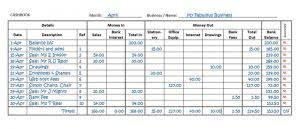
Project-based accounting is the technical term for the style of accounting used in construction. It treats each construction project independently, complete with a budget, as well as detailed revenue and expense tracking. In order to do this well, you and your accountant must be meticulous when it comes to revenue recognition and expense tracking on a per project basis. In contrast with the PCM, incremental contract activity is not recorded in the income statement with CCM. Instead, your costs are recorded as “work in progress” (an inventory account), and your revenue is recorded to progress billing.
Exempt Percentage of Completion Method
However, after contract completion, your actual cost was $2,900,000, so the $300,000 of costs incurred in the 1st year exceeded 10% of the total actual costs. Therefore, you must use the lookback method to calculate the amount of interest to pay, based on what should have been reported minus what actually was reported. CCM is generally advantageous because it defers revenue longer than either the cash or accrual method of accounting. Specifically, it would allow you to defer tax on those construction contracts until they are complete. You would continue to use your normal accounting method (cash or accrual) for your other business activity.
Which of the two methods is easier to record?
With this method, no income or deductions are recognized until the contract is complete. When you “recognize” income, you are recording it for tax or other reporting purposes. completed contract method In this method, revenues and expenses are recorded when the sale is closed. It is specifically useful for longer-duration projects that span multiple accounting periods.
- Under the CCM, no revenue or expense is recognized in year one—and the full contracted amount of expense and revenue is recognized in year two.
- Actual costs paid and cash payments received in 2023 and 2024 are summarized below.
- Construction contractors generally must account for long-term contracts using the percentage of completion method of accounting under IRC Code Sec. 460, unless an exception applies.
- In other words, the amount of taxable income reported can vary from one year to the next depending on which jobs are finishing in each particular year.
- This means the contractor can recognize half of the total revenue for the project.
By Industry
This can present challenges when the revenue and expenses recognized are different from the actual amounts billed or spent on the project. This can create cash flow problems for the contractor if they aren’t careful. With the CCM, revenue and expenses are not put on an income statement until the contract is complete. In the meantime, that activity would be reported on the balance sheet, and changes to your balance sheet are made through adjustments to your balance sheet accounts.
It won’t set your company up for long-term growth and will limit the amount of actionable information you can gain from your financial data. Note that the $1 million exception would apply to contractors with revenues exceeding $300 million over the previous 3 years. The IRS generally requires that companies with long-term contracts use the PCM—unless one of the exceptions below applies. Most companies will want to use the CCM if they qualify under one of these exceptions. On 1 January 2011, it won a 3-year contract to construct an intra-city dedicated bus tracks for a total price of $300 million. In 2025, the balance sheet activity for both years is moved to the income statement.

How do I treat expenses that are incurred after the contract is completed using CCM?

Construction projects take time, and because of that, they require significant upfront costs for labor, materials and equipment…. Meet a Knowify expert on a video screenshare, get your questions answered, and ensure you’re set up for organized, profitable projects with Knowify. In other words, you can acknowledge that you’ll pay this money later, but you can account for it right away.
IRS requirements
- It will still yield the same results as the commonly used percentage of completion method, except that revenue recognition comes at the end of the project.
- When in doubt, work with a certified professional accountant to set up the accounting system that will work best for your business.
- The tax liability would be higher under the completed contract method versus using the percentage of completion approach since some of the revenue would have already been recognized.
- The company estimates its total cost to complete the structure will be $3 million.
- Instead, GAAP requires accrual accounting, as it does a better job of accounting for a company’s genuine financial standing.
- If a contractor uses the overall cash method of accounting, no additional methods need to be applied to the jobs in progress.
- You don’t necessarily need to implement extensive accounting practices or bring on financial experts to get by.
However, it’s not good when there’s a lot of uncertainty about how much the project is done or how much it will cost to finish. Our ACA reporting & e-filing services include https://www.bookstime.com/ official 1094-C and 1095-C IRS reporting, optional e-filing (no applying for a TCC code required), mailing to your employees and experienced support to help you.
The threshold is determined on a controlled group basis, so if there are several companies with common ownership, businesses will need to analyze whether those controlled group rules apply. This creates a distortion of earnings that is lopsided to the end of a project. For this reason, you should only consider it for situations where you can’t figure out job progress in a logical way (i.e., there are no reliable milestones to base payments around). You’ll accumulate all billing and related costs in a balance sheet using a percentage of completion or construction in progress account. While we always recommend that you work with an accountant, it’s crucial that you have a firm grasp of these accounting methods yourself. This will allow you to better work with your accountant to understand why your business performs as it does.

The tax liability would be higher under the completed contract method versus using the percentage of completion approach since some of the revenue would have already been recognized. Under this method, revenue is recognized when it is billable under the terms of the contract and expenses are deducted when they are incurred, regardless of whether the job is complete or in progress. The percentage of completion and completed contract methods are often used by construction companies, engineering firms, and other businesses that operate on long-term contracts for large projects.
Percentage of Completion-Capitalized Cost Method
There should be no terms in the contract with the only purpose of deferring tax. The Completed-contract method is an accounting method of work-in-progress evaluation, for recording long-term contracts. GAAP allows another method of revenue recognition for long-term construction contracts, the percentage-of-completion method. The contract is considered complete when the costs remaining are insignificant. This method requires contractors to use a separate, dedicated balance sheet to record their expenses and revenues.
